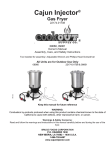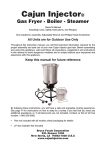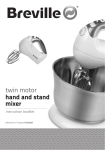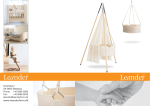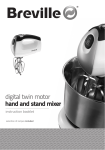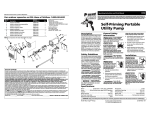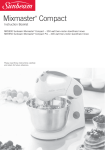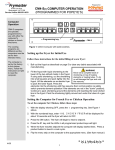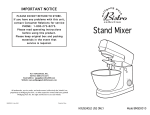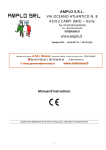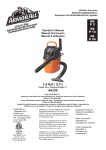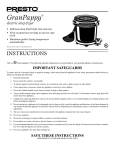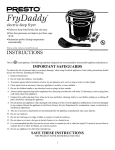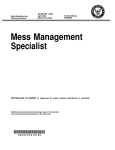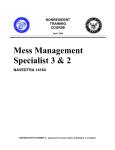Download Cajun Injector®
Transcript
Cajun Injector® Electric Fryer - Boiler - Steamer Owner’s Manual Assembly, Care, Safety Instructions, and Recipes Bruce Foods Corporation P.O. Drawer 1030 New Iberia, LA 70562-1030 U.S.A www.cajuninjector.com Important Safeguards When using electrical appliances, basic safety precautions should always be followed, including the following: 1. Read all Instructions. 2. Do not touch hot surfaces. Use handles or knobs. 3. To protect against electric shock do not immerse cord, plugs, or removeable heating element in water or other liquid. 4. Close supervision is necessary when any appliance is used by or near children. 5. Unplug from outlet when no in use and before cleaning. Allow to cool before putting on or taking off parts, and before cleaning the appliance. 6. Do not operate any appliance with a damaged cord or plug or after the appliance malfunctions, or has been damaged in any manner. Return appliance to the nearest authorized service facility for examination, repair or adjustment. 7. The use of accessory attachments not recommended by the appliance manufacturer may cause injuries. 8. Do not use outdoors. 9. Do not let cord hang over edge of table or counter, or touch hot surfaces. 10. Do not place on or near a hot gas or electric burner, or in a heated oven. 11. Extreme caution must be used when moving an appliance containing hot oil or other hot liquids. 12. Always attach plug to appliance first, then plug cord in the wall outlet. To disconnect, turn any control to “off,” then remove plug from wall outlet. 13. Do not use appliance for other than intended use. 14. “Extreme caution must be used whn moving fryer containing hot oil.” 15. SAVE THESE INSTRUCTIONS. 16. Notice, a short electrical cord is provided to prevent the possibility of anyone or anything from being entangled or tripping over during use. This could occur when using a longer extension cord; and, hence, we recommend your use of the shorter cord when using this product. 17. Do not leave this appliance unattended while it is in use. 18. The cord should always be secured in order to prevent the chances of an accident. Note: a breakaway cord is provided for safety. 19. If oil begins to smoke, immediately turn appliance off, as oil may be too hot. Check temperature, it should not exceed 375˚F. Oil may also be old and in need of replacement prior to frying new product. 20. Never overfill cooking pot. Never exceed the kettle’s maximum fill line. When in doubt, fill the pot to the max fill line with cold water, then immerse product to be cooked to be sure that overflowing or spillage is not a concern. 21. Open transparent lid with caution to prevent being burned by the escaping steam. 22. Never place face or body parts in a position to be burned by steam when opening the fryer lid. SAVE THESE INSTRUCTIONS RECOMMENDED: DO NOT USE AN EXTENSION CORD WITH THIS PRODUCT The use of an extension cord increases the risk of entanglement or tripping. The use of an extension cord can cause loss of energy and the appliance may not heat properly. PARTS LIST EF1 - OUTER POT EF3 - CONTROL PANEL AND HEATING ELEMENT EF5 - LID EF4 - BAILING BASKET EF6 - POWER CORD EF7 - LIFTING HOOK EF2 - INNER POT • EF1 - Outer Pot (1) • EF2 - Inner Pot (1) • EF3 - Control Panel and Heating Element (1) • EF4 - Bailing Basket (1) • EF5 - Cover (1) • EF6 - Power Cord (1) • EF7 - Lifting Hook (1) Once opened, DO NOT RETURN THIS APPLIANCE TO RETAILER For assembly assistance, or to report missing or damaged parts Phone: Bruce Foods Corporation Customer Service at 1-800-299-9082 Assembly Instructions Step 1 • Align drain valve on inner pot with fryer door on outer shell before inserting pot into shell, so that drain valve shows through open fryer door. CONTROL PANEL AND HEATING ELEMENT INNER POT OUTER POT Step 2 • Attach control panel and element to outer shell mounting bracket. OUTER POT CONTROL PANEL HEATING ELEMENT BACK HEATING ELEMENT SUPPORT UNIT • Control must be correctly attached for appliance to operate. A built in safety switch on the control panel will prevent this unit from heating if not mounted properly prior to turning on electric current to this product. Assembly Instructions Step 3 • Place aluminum fryer basket inside metal inner pot. Step 4 • Place glass lid on last after assembly of all other parts. Align the notch on the lid with the metal coils on heating element. Note: Glass lid will not fit tightly when basket is in use during cooking process. Step 5 Power Cord Connection • Connect the power cord to the connection under the control panel and heating element. Drain Valve Operation (select models only) • The drain valve, located near the bottom rim of the frying pot, allows you to safely and easily drain water/oil from the pot. • BE SURE THAT ANY LIQUID INSIDE OF THE POT IS BELOW 100°F BEFORE DRAINING. • Liquid should primarily be drained into a container before disposal. • Place your desired reservoir directly under the drain valve nozzle; be sure that both the reservoir and the fryer are sturdy and not easily tilted. • Turn the black switch on top of the drain valve nozzle 180°F or until a steady flow of liquid is being dispersed from the nozzle into the reservoir. • Close the valve by turning the switch to its original position once all of the liquid has drained. • Some frying oils can be reused within a few days; many people find the drain valve a useful mechanism to direct their frying oil back into its original container to be used at a later date. Quick Drain System • • • • • • Locate the two hooks on the inside of the pot not far from the upper rim; these are the Quick Drain Hooks. Two oval shaped holes can be found on the basket: One is labeled “turkey” and the other is labeled “seafood”. The basket is designed to hang from the hooks by slotting the Quick Drain Hooks through either one of the two oval shaped holes in the basket. When proper cooking time has elapsed, you are ready to drain the excess liquid from any food in the basket. While wearing protective frying gloves, use the included metal hook to lift the basket by the swiveling metal handle. Hang the basket from the Quick Drain Hooks by inserting the hooks into either the “turkey” hole or the “seafood” hole, depending on the type of food being cooked. Allow the food to drain for at least a few minutes or until you are positive that most of the excess liquid has fallen back into the pot. NEVER remove basket from fryer pot without first allowing the food to drain. The Quick Drain System can also be used to steam seafood. Place 6 inches of water at the bottom of the pot, hang the basket from the Quick Drain Hook labeled “Seafood,” and cover with the lid. Cooking times will vary depending on the type of food being steamed. Starter Tips BAILING BASKET HOOK TO DRAIN TURKEY BAILING BASKET HOOKED FOR SEAFOOD BOILING For best results, read the following Starter tips before using this product. • Please keep in mind, this is an electric fryer. It has different heating characteristics than a gas fryer. • For safety: the heating element will only heat when it is properly attached to the mounting bracket (see assembly instructions). This is a powerful heating element and may cause the circuit breaker to trip. Operating any additional appliances on a separate circuit should minimize such occurrences. Tripping of the circuit breaker will not damage either the unit or any household electrical systems. • Pre-heating oil or water may take thirty minutes or more depending on initial oil temperature and weather conditions. Take advantage of this time to prepare foods for cooking. For best results, completely pre-heat unit to cooking temperature before frying or boiling foods. • Reduce heating time and keep temperature more consistent by keeping the lid on the pot during the preheating and cooking processes. • For cooking a turkey-When the desired temperature is attained and the turkey is placed in the oil, the temperature of the oil will naturally be reduced because of the lower temperature of the turkey. The LCD readout will display the temperature throughout this process. Temperature is displayed when the turkey is placed in oil and while the oil returns to desired cooking temperature. • “Recovery time” is the amount of time required to bring the oil back to frying temperature once the items being boiled or fried are immersed in the liquid medium. This time can be best controlled by bringing foods to ambient temperature and limiting the amount of foods placed in the fryer basket for immersion at any one time. With larger pieces such as a 12-pound turkey, we recommend allowing oil to reach 375˚F prior to immersing the bird and then setting the control back to 350˚F (the recommended frying temperature.) • When the desired heating temperature for cooking is attained, the heating element will automatically turn off. When the temperature falls 5˚F, the heating element will automatically turn on again until the desired cooking temperature is reached. This Automatic process will repeat and display on the LCD, as “heating” and “Ready”. • To illuminate the Backlighting of the LCD display, press the “UP” arrow or the “DOWN” arrow. • The red power light illuminates only to indicate that the power cord is plugged into an electrical outlet. This product will not commence heating until the “START” button is pushed. • The timer on this product is completely separate from and does not control the heating element. The Heating Element will not turn off automatically when the timer beeps. The temperature controller for this unit must be manually turned off. • When the LCD readout reads “ERR,” no buttons will function except On/Off. Turn the unit off immediately, wait 15 minutes and then turn fryer back on. Operating Instructions • Step 1 Mount control panel with heating element into bracket on outer shell of the unit. • Step 2 Plug power cord into an outlet (refer to “User Precautions and Important Safety Tips” section of manual). Power light will illuminate indicating the unit is plugged in, and the heating element is mounted correctly; and controller on unit is ready to be activated. • Step 3 Note: The Temperature Controller must be set prior to the timer functioning. To set temperature: • Press ON button. • Press TEMP MODE button once; the LCD display will blink. • Use UP and DOWN arrow buttons to set temperature. • Press START button, this will turn the heating element ON. To set timer: • Press TIME MODE button once; LCD display will blink. • Use UP and DOWN buttons to set TIME in MINUTES. • Maximum Time is 90 minutes. • Timer will automatically start after you have selected Time. • Step 4 When cooking time has elapsed and food is done, press ON/OFF button to turn off heating element and unplug power cord. When lifting food out of cooking liquid, allow excess oil or water to drain from the fryer basket by hooking the basket on side of pot. Remove the drained basket shortly thereafter. When using the quick drain system, make sure that the basket is firmly in place on rim of pot before releasing handle so basket will not fall back into hot oil or water causing injury. Do not use appliance without water or oil in pot. It can be severely damaged and dangerous to the user if heated while empty. Always place unit on a level, very stable surface to prevent tipping over Do not mix different types of oil at the same time. Purchase a commercial blended oil if so desired. Never melt or use shortening, solid fats or lard in this appliance. RESET FUNCTION • This device uses a safety feature that will automatically shut off the appliance if it overheats. • To reset, remove plug from outlet. Insert a small sharp object into the small hole on back of the control panel. CLEANING INSTRUCTIONS • Bruce Foods recommends cleaning unit before every use. • Cleanse cover, pot, and basket with a moist sponge or rag using a mild detergent. Rinse and dry thoroughly. These parts are dishwasher safe. • Cleanse outer shell, cord, control panel and element with a moist sponge or rag using a mild detergent. Dry thoroughly. DO NOT put these parts in a dishwasher. • Do not submerge or run water over control panel or cord; doing so may cause electrocution. PRESERVATION & STORAGE • Disconnect electric cord from outlet prior to cleaning, servicing, and/or removing heating element. Electric shock may cause personal injury or death. • Turn appliance off, unplug and let cool for 2 hours if using water, 5 hours if using oil before cleaning or storing. • Never pour used oil in sink; rather drain it back into oil containers. HOW TO STEAM USING APPLIANCE Add water until it reaches bottom of the basket. Do not allow water to evaporate. This will cause the element to overheat and can damage the unit. QUESTIONS Why can’t I turn my turkey fryer on? The Control Panel includes a “Safety Switch” that must be aligned correctly for element to power on. A green light will illuminate when control panel is mounted correctly. How much oil do I need to use? Frying with this appliance will require approximately 1.5 gallons (5.7L) of oil. The fill line marks the maximum amount of liquid that the appliance can safely contain. The max fill line provides for ample liquid to cook any meal in this appliance. What type of oil should I use? Cottonseed oil is recommended because of the great taste and higher smoke point, but any common cooking oil may be used. How hot will the oil become? After not more than 55 minutes, oil will typically reach 400˚F (204˚C). This time is dependent on ambient temperature of the oil and weather conditions. When turkey is placed in fryer, oil temperature will drop to around 275˚F (135˚C); this is a suitable temperature for frying a turkey. Should the lid stay on during use? Yes, the lid helps to retain heat and keeps splashes inside the unit. What size turkey can I deep fry in this appliance? Any turkey 14lbs. (6.35kgs) or less can be fried in this unit. Can I use an extension cord with this appliance? No, an extension cord will weaken electrical current which will increase cooking time and lessen performance. The risk of tripping or knocking over this unit is increased with the use of extension cords. Which way should the turkey face when frying? Turkey and turkey breasts should be placed horizontal in the basket with the breast side facing up. I followed the instructions and the turkey wasn’t fully cooked. What went wrong? Cooking conditions may vary; the turkey may have been excessively cold. Always bring the turkey to room temperature before frying. Occasionally, a cold or frozen spot in a joint or deep in the turkey breast does not allow that section to cook properly. Can the Electric Turkey Fryer be used outdoors? Cajun Injector does not recommend using this turkey fryer outdoors. If you do not want to use this appliance in your house, use in a garage or covered patio to prevent the Electric Turkey Fryer from being exposed to precipitation. Troubleshooting Guide Problem Reason Possible Solution Power light will not come on Unit not plugged into wall Check wall connection Break-away cord is loose or not connected Disconnect and reconnect power cord sections Control Panel is not attached to outer shell correctly Remove and reinstall. Make sure panel is aligned with arrows on outer shell bracket to engage safety switch. Household fuse is tripped Make sure other appliances are not operating on the same electrical circuit. Check household fuses. Start button has not been pushed Unit will not begin heating until start button is pressed Temperature set point already reached Allow unit to cool below set point or enter higher set point Controller malfunctioning Contact Bruce Foods at 1-800-299-9082 Unit plugged into an extension cord Place unit so an extension cord is not needed Lid not in place Place lid on unit to retain heat Controller malfunctioning Contact Bruce Foods at 1-800-299-9082 Appliance overheats, then shuts off Temperature sensor malfunctioning, overheat sensor shutting unit off Contact Bruce Foods at 1-800-299-9082 LCD not displaying correctly Moisture in controller Allow unit to cool and dry out before attempting to use again Controller overheating Contact Bruce Foods at 1-800-299-9082 Controller malfunctioning Contact Bruce Foods at 1-800-299-9082 If none of these solutions work, reset unit (page 5 in manual). If unit still does not work, contact Bruce Foods Corporation at 1-800-299-9082 Power light is on, unit is not heating Unit takes excessive amount of time to heat up (longer than 1 hour and 15 minutes) If symptom is not listed, please contact Bruce Foods Corporation at 1-800-299-9082 Frying Non-Frozen Foods (Oil may take up to 55 minutes to reach desired temperature) Food French Fries Fried Chicken Mushrooms Fish Fillets Whole Turkey Hot Wings Maximum Quantity Temperature Time 3 lbs. (1.36 kg) 400˚F (204˚C) 5-7 minutes 8 pieces 350˚F (177˚C) 14-18 minutes 2 lbs. (0.91 kg) 325˚F (163˚C) 10-12 minutes 2 lbs. (0.91 kg) 400˚F (204˚C) 6-8 minutes 10-14 lbs. (4.5-6.4 kg) 400˚F (204˚C) 3 lbs. (1.36 kg) 400˚F (204˚C) 3 min. per lb. (0.45 kg) plus 5 minutes 8-10 minutes Frying Frozen Foods (Refer to instructions on food packaging first) Fried Okra Chicken Nuggets Mushrooms Fish Sticks Corn Dogs Cheese Sticks 3 lbs. (1.36 kg) 400˚F (204˚C) 5-7 minutes 2 lbs. (0.91 kg) 375˚F (191˚C) 7-8 minutes 2 lbs. (0.91 kg) 375˚F (191˚C) 8-9 minutes 2 lbs. (0.91 kg) 375˚F (191˚C) 6-7 minutes 10 lbs. (4.5 kg) 375˚F (191˚C) See packaging 2 lbs. (0.91 kg) 325˚F (163˚C) See packaging Boiling Non-Frozen Foods Corn on the Cob Shrimp Red Potatoes Eggs Pasta Shells Hot Dogs 15-20 cobs 250˚F (121˚C) 5-8 minutes 10 lbs. (4.5 kg) 250˚F (121˚C) 3-4 minutes or until pink 10 lbs. (4.5 kg) 250˚F (121˚C) 25 minutes 1 dozen 250˚F (121˚C) 10 minutes 3 lbs. (1.36 kg) 250˚F (121˚C) until tender 50 250˚F (121˚C) 2-3 minutes Steamed Foods (Refer to instructions on food packaging first) King Crab Legs Clams/Mussels Yellow Squash with Red Peppers Blue Crabs Lobster 3 lbs. (1.36 kg) 250˚F (121˚C) 5-8 minutes 10 lbs. (4.5 kg) 250˚F (121˚C) 5-7 minutes or until open 2 lbs. (0.91 kg) 250˚F (121˚C) steam until tender 10 250˚F (121˚C) 6-10 minutes 1-4 250˚F (121˚C) 10-12 minutes Do not place frozen poultry in oil. Use extreme caution when cooking frozen foods. Do not fill oil past fill line or exceed maximum amount of food in basket. Spillover can cause serious injury. Slowly lower basket into hot oil and cover with lid. Always wear protective gloves or mitts. Always pat dry moisture off the food pieces prior to frying. When using the quick drain system, make sure that basket is firmly in place on rim of pot before releasing handle so basket will not fall back into hot oil or water. Techniques for Successful Preparation of Fried Foods at Homes Often when someone mentions frying foods at home, they are greeted with a chorus of negative comments ranging from messy, greasy, and dangerous to unhealthy. Utilizing the proper equipment and learning the correct methods and procedures, frying can overcome virtually all of these comments. No doubt, breading or battering foods and frying “in oil,” does add caloric content to foods. But, a sensible respect for portion sizes consumed and utilization of non-hydrogenated oil with zero trans fats greatly reduces the concern of “unhealthy” often expressed. Education in the proper procedures and techniques that should be employed when frying, greatly reduces the amount of oil absorbed by fried foods. Frying Techniques and Temperature Control of the Cooking Oil All forms of frying involve the cooking of food in oils or fats. Frying techniques vary depending on the frying vessel utilized (such as a wok utilized in stir-frying, a frying pan, or a deep fat fryer); the amount of fats or oils required (from sautéing or stir frying to pan frying to deep fat frying); cooking temperature; and preparation methods employed with foods for frying. For the purposes of this pamphlet, we’ll concentrate on pan frying, deep fat frying, and mention a baking misnomer, oven frying, which is actually a form of baking. Frying is classified as a form of dry-heat cooking since water is not utilized to transfer heat to the food being cooked. Instead, the heat in the oil is transferred to the water in the food so that the moisture in the food turns to steam to cook the food from the inside out. Whatever form of frying employed balances the realities of time, temperature, and the surface area of food in contact with the oil, plus the food’s structure and moisture. Often this means assuring that the food is fully cooked in the interior before being burned on the exterior. As an example experts recommend panfrying nothing thicker than 1-inch as the exterior is likely to burn before the inside is fully cooked. Maintaining proper oil temperature is absolutely crucial to all forms of fried foods. Recommended oil temperature ranges from 350˚F – 375˚F with a target temperature of 365˚F. And virtually all frying tips seek to assist you in maintaining correct oil temperature. Hot oil causes the food’s internal moisture to turn into steam that keeps the oil out while the hot oil also keeps the moisture in (especially when a batter or breading barrier is used around the surface area of the food forming a crunchy, brown crust). If the oil is too hot, the steam reduces the moisture content and overcooks the food. On the other hand, if the oil temperature is too low, a lack of steam allows the oil to penetrate deep into the crust producing oily, unappetizing fried food. The oil must be hot enough to quickly seal the surface of the food, but not too hot to burn the outside before the inside is completely cooked. Done correctly at a proper temperature, only a minimal amount of oil is absorbed into the food. Pan Frying This form of frying is characterized by the use of significantly less hot oil where food is semi-submerged in hot oil in an electric skillet or in a fry pan over an open flame. When pan-frying, the oil’s depth should be no more than 1/2 the thickness of the food. Pan frying differs from deep frying since the food touches the bottom of the pan and the exposed top side of the food allows some loss of moisture in the food as it cooks. The advantage of pan frying is the use of less oil, this is also a disadvantage as it is more difficult to maintain temperature of the oil. The moisture loss and faster browning of pan fried foods can be advantageous or detrimental depending on the choice of foods to be pan fried. The best candidates for pan frying include fish, shellfish, tender meats and vegetables. Foods to be pan fried are generally covered with a batter or breading and have a rich texture that contrasts with the crispy, crunchy outside. When pan-frying use an electric skillet with a thermostat to control oil temperature if possible. Otherwise, some experimentation may be required to control oil temperature. When oil temperature is reached, add the food to the pan; and fry on one side until brown. Using tongs or a spatula (never a fork) turn and brown the second side realizing that the second side generally takes less time (it’s hotter when turned over than the first side was) to cook. As with all forms of frying, never crowd the pan as this can dramatically reduce oil temperature. Recovery time is the duration of time necessary to return the oil to the desired cooking temperature. When cooked too long, food will likely be greasy without the seared crunchy exterior most people desire from fried foods. Oven Frying Oven frying produces a result that is healthier (usually less oil yet similar to fried foods even though it isn’t a real frying process. Generally food is baked in a hot oven and basted once with a small quantity of fat or cooking spray. As with deep-fried foods, most foods are breaded or battered prior to being baked to seal in the juices and produce a crunchy, crispy crust. Food normally does not require turning and cooks quickly using this high heat (450˚ – 500˚F) method. This works especially well with fish fillets, chicken pieces and pork chops. Generally bread crumbs or corn flake crumbs are utilized to produce a crispy crust when oven-frying. The Basics of Frying: 1. Recommended Products : A quality candy or deep-frying thermometer. A deep fat frying thermometer, preferably with a clip that allows the thermometer to be affixed to the side of the frying vessel is essential, since accurate control of the temperature of the frying oil is essential to successfully fried foods. 2. An Electric Skillet is preferred for pan frying; otherwise, choose a pan with a thick heavy bottom that is larger in circumference than the heat source (this will prevent oil from dripping down the exterior of the pan into an open flame that might cause a fire.) Use a heavy skillet or frying pan that is wider than it is deep and has a heavy bottom to help regulate uniform heat from the bottom of the pan. This is absolutely essential when pan frying with limited amounts of oil. 3. A Cajun Injector Electric Fryer for deep fat frying with digital timer and thermometer, basket, clear cover, and petcock drain spout specifically designed for high heat frying of large items such as turkey as well other deep fried foods. Deep Frying Foods to be deep-fried should be of a size and shape that permits individual pieces to float freely in the fat. The fat should surround the food and begin cooking it on all sides at once. The food is usually battered or breaded to protect the food’s surface moisture from coming into contact with the hot oil creating an exterior layer or crust sealing food flavors and juices inside. We suggest the following tips: 1. Use a pan wider than it is deep, and that is wider than the heat source (so oil won’t come in contact with direct heat.) Always use clean, fresh oil or previously used oil, properly filtered and refreshed by frying a raw potato or handful of parsley for about five minutes prior to frying food for dinner. Delicate foods should not be fried in oil previously used to fry strongly flavored foods. 2. Much of fried food odors can be absorbed by placing a small cup of bleach nearby. Be sure to mark as “Bleach” and keep children away from the cup as well as from the hot oil. 3. Never fill your fryer more than half full of oil. You will need a minimum of three inches between the oil surface and the top of the pot. 4. Constantly monitor temperature of the oil. Never crowd the frying oil, fry in small batches. The oil should freely bubble around each piece of food at correct temperature. 5. Use proper tools when removing fried foods and draining oils to a plate with several layers of paper towels. To add more absorbency, place a brown paper bag below the paper towels on the plate. 6. Keep deep-fried foods warm by placing in a single layer on fresh paper towels (after initial draining step above is finished) in a 250˚F oven while you complete frying. Choice of Oil or Fat as a Frying Medium: 1. Your choice of Oil or Fat often depends on the frying technique to be utilized and the projected frying temperature. As an example, when sautéing, oil choice often depends on the flavor to be imparted as butter or bacon grease are often employed. Olive oil is also a good choice if temperatures not over 300˚F are to be employed in sautéing or pan-frying. 2. Health Concerns can determine your choice. We recommend non-hydrogenated oils with zero trans fats and zero cholesterol. This eliminates the use of animal fats. 3. Smoke point is a stage at which fat or oil begins to smoke. Utilize oils with a high smoking point (above 400˚F). and high stability. Most vegetable oils have smoking points over 400˚F and can be used in all cooking methods. 4. High heat, water, and burned food particles break the oil down over time. Filter the oil after use. Allow the oil to cool after use and filter to remove all food particles that could burn during reuse. 5. Replace your old oil if you notice the following symptoms: Excessive smoking at normal temperatures; strong oil discoloration; rancid odor. Choice of Coating Mix, Breading Mix, or Batter Mix: A breaded item is any food that is coated with bread crumbs, cracker meal, corn meal, or other dry meal to protect it during cooking. Breaded foods can be seasoned, marinated, or rubbed prior to breading, or seasonings may be added to the flour, crumbs, or meal, before the coatings are applied. Coating batters are liquid or semiliquid mixtures, utilizing flour, milk, and eggs, used in cooking. 1. When breading meats, chefs call a three-step process “the standard breading procedure.” First, pat the food dry (always reduce moisture as much as possible to reduce splattering and oil degradation) and then dredge in seasoned flour. The flour adds seasoning and allows egg wash to adhere. Next dip the floured food in an egg wash (egg wash should contain whole eggs whisked together with approximately one tablespoon of milk or water per egg.) Egg wash will cause the breading to coat the item and form a tight seal when food is cooked. Lastly, coat the food with crumbs or seasoned meal, shake off the excess and place in a container in a single layer. 2. Battering. Prepare the batter according to directions. Pat the food dry, dredge in seasoned flour, if desired. Dip the item in the batter and generally cook immediately. There are some chefs that recommend chilling the batter with ice or refrigeration to obtain a great sear and those who recommend battering by placing in a single layer and refrigerating for up to 30 minutes to dry the batter. When using these methods, be sure to cook very small batches so as to maintain oil temperature. For Gulf Coast Style Seafood Boil 5 lbs. Shrimp * 8 Medium Crabs * 4 lbs. Crawfish * Vegetables 1. Wash Shrimp or seafood in cold water. Confirm crabs and crawfish are alive prior to boiling (crabs and crawfish should be alive at time of cooking). Purge Crawfish in salted water. 2. Place products to be boiled inside the basket. Be sure that water displacement does not exceed the capacity of the boiling pot. This can be checked by placing all the ingredients in the pot and placing the basket in the cold water (prior to heating) to be sure that the boiler will not overflow the pot. 3. Measure out water (not to exceed 3-gallons) following the instructions on your favorite seafood boil package. For a spicier boil, add 1 12-oz. bottle of The “Original” Louisiana Brand Hot Sauce per package of spice mix used. Bring to a boil. Add boil mix contents, for mildly seasoned, non-messy food or for spicy, hot cooked seafood or vegetables, reserve 2 Tbsp. spice mix per package for sprinkling over seafood or vegetables (after draining and prior to eating). 4. First add favorite selected vegetables (optional step) such as small white or red potatoes, mushrooms, corn, garlic pods, lemon slices and small onions to the boiling mixture. Hard simmer in boiling solution for 10 minutes or until vegetables are cooked. Cut heat and allow to soak in mixture for 10 minutes. Remove vegetables. Return solution to a boil. Add Seafood; return to boil, timing shrimp 3-minutes; Crabs or Crawfish 8-10 minutes depending on size. 5. Remove from heat. Add ice to stop cook (being sure not to overflow the boiling pot) and allow to soak for 10-15 minutes prior to draining and pouring out of container. Sprinkle reserved spicy boil mix over boiled seafood prior to eating. 6. To double the amount being boiled: Add an additional 1-1/2 gallons Water (Total 3-Gallons) along with an additional 1/3 cup of Salt; 1/2 cup of Red Cayenne Pepper, and an additional 12-oz. bottle “Original” Louisiana Brand Hot Sauce to the directions given above. Chesapeake Style Steamed Crabs or Seafood Crabs * Crawfish * Fish * Vegetables 1. Utilize a boiling pot with a raised rack a minimum of 2-3 inches above the bottom of the boiling pot. Add equal amounts of water and vinegar to a water level just below the rack. Optional: Add a bottle of 12-oz. “Original” Louisiana Brand Hot Sauce to the water-vinegar mixture. 2. Layer Crabs or other foods to be steamed. Sprinkle your favorite spice mix lightly, or until partially covered, and steam in covered pot until crabs turn red, or other foods are fully steam cooked. Injectable Marinade Concepts and Utilization Techniques Injectable marinades and brines possess the same characteristics as their counterparts except that they do not require product soaking in order to impart flavor; moisturize, and tenderize. Unlike marinade soaking methodologies that only penetrate about a 1/4 inch into meat surfaces, require long soak times, and contaminate expensive marinades, flavor injection infuses blended flavors deep inside the meat. Conceptually the flavor injection concept makes good sense: instant flavor, yet no waiting, no waste as marinade is injected, and no fats are required in the marinades to protect the meat surface during soaking time. Rubs, seasonings, and sauces are used to flavor the surface of the meat. As with many culinary skills, proper technique when “flavor injecting” will result in superior results. The flavoring should be spread uniformly throughout the meat with as few punctures of the meat as possible. The flavor injector is a syringe with a needle attached to a plunger which allows the user to inject the flavoring deep into the meat. Injecting Tips for poultry start with limiting the puncture holes and when possible separating the skin from the meat and puncturing directly into the geometric center of the meat. Carefully and slowly inject along the grain of the meat aiming the injector into the middle of the meat and reduce plunger pressure on liquid as the needle comes nearer the surface of the meat (so meat can close up behind the needle.) Do not pull the needle completely out of the puncture hole unless to reload with liquid. Use the same hole to angle into the other areas of the meat, slowing infusing flavor as the needle moves back toward the meat surface. Remember the object is to spread your injection pattern so as to get small amounts of flavor in as many places as possible. Occasionally, some of the liquid is likely to spurt out on the meat surface. Rub the flavoring over the surface of the meat and then rub and season the surface of the meat as desired. Injecting Techniques 1A 1. Attach injector needle by turning clock-wise until snug. Do not over tighten. Hint: Be sure rubber plunger is lightly coated with oil prior to using. Determine amount of marinade required (1.5 to 2 ounces per pound of meat) and measure out contents into a clean container to prevent contamination of unused marinade. 2. Pull plunger to draw marinade into injector. Hint: Both slots in needle should be immersed in liquid to prevent air from entering injector chamber. 3. For best results, a geometrically centered injection point should include one deep and straight needle track as well as two additional tracks at approximately 45 degree angles branching out from the original injection point. (See illustration 1A) 2 1B 4.Once inserted deep into meat, press plunger down while slowly pulling injector needle out of meat to ensure even distribution of marinade. Follow same procedure with each needle track at each insertion point. 5.See illustration 1B for suggested insertion points for turkey. 6.See illustration 2 for suggested insertion points for roast. Cajun Injector® Deep Fried Turkey Prep Time: 20 minutes Cook Time: 35-45 Minutes Yield: 8 servings Ingredients: 1 Cajun Injector® Propane Fryer 3 Gallons Cajun Injector® Cottonseed Oil 1 10 - 12 Pound Whole Turkey 2 16 oz. jars Cajun Injector® Creole Butter Recipe Marinade 1 8 oz. canister Cajun Injector® Quick Shake® Cajun Shake® Method: Place the outdoor gas burner on level dirt or grassy area. Never fry a turkey indoors, in a garage, or in any structure attached to a building. Do not fry on wood decks, which could catch fire, or concrete, which could be stained by the oil, (have a fire extinguisher nearby for added safety). Add oil to a 7 to 10 gallon pot with a basket. At medium-high setting, heat the oil to 350°F (depending on the amount of oil, outside temperature and wind conditions, this should take about 20 to 40 minutes). Remove the giblets and neck from the turkey. Cut off the wing tips and plump little tail as they may get caught in the fryer basket. Rinse the turkey well with cold water, and pat dry thoroughly with paper towels. Take care to dry inside the cavity. Place in a large pan and inject with 2 ounce per pound of Cajun Injector Creole Butter Recipe Marinade. Season liberally inside and out with Cajun Injector Quick Shake Cajun Shake. To allow for good oil circulation through the cavity, do not truss or tie legs together. Place the turkey in basket, neck down. When the deep-fry thermometer reaches 350°F slowly lower the turkey into the hot oil. The level of the oil will rise due to the frothing caused by the moisture from the turkey but will stabilize in about 1 minute, (to prevent burns from the splattering oil wear oven mitts/gloves, long sleeves, heavy shoes, and even glasses. It is wise to have 2 people lowering and raising the turkey). Immediately check the oil temperature, and increase the flame so the oil temperature is maintained at 350°F. If the temperature drops to 340°F or below, oil will begin to seep into turkey. Fry about 3-1/2 minutes per pound, or about 35 to 45 minutes for a 10 to 12 pound turkey. Stay with the cooker at all times, as the heat must be regulated. When cooked to 170°F in the breast or 180°F in the thigh, carefully remove the turkey for the hot oil. Allow the turkey to drain for a few minutes. Remove the turkey to a cutting board and cover with foil. Let it rest for 20 minutes. Slice the turkey and serve hot. Original Louisiana Habanero Fried Chicken Prep time: 20 minutes Marinate time: 4 hours Cook time: 30 minutes Yield: 8 servings Ingredients: Cajun Injector® Cottonseed oil, for deep-frying 1 Quart Buttermilk, Plus 2 Cups 2 tbsps. Cajun Injector® Quick Shake® Cajun Shake® seasoning 2 tbsps. Louisiana Brand Hot Sauce 2 tsps. Louisiana Brand Habanero Sauce 2 Chicken (3 to 4 pounds each), Each Cut Up Into 8 Pieces 4 cups All-Purpose Flour 1 tbsp. Garlic Powder 1 tbsp. Onion Powder 1 tbsp. Sweet Paprika 2 tsps. Cayenne Pepper Method: In a large bowl or baking dish, whisk together 1 quart of the buttermilk, Cajun Injector® Quick Shake® Cajun Shake® seasoning, and 2 Tablespoons Louisiana Brand Hot Sauce. Add the chicken pieces, turn to coat, cover, and refrigerate for at least 4 hours or overnight. Preheat oil to 400˚F in electric fryer, or 350˚F in propane fryer. Place the remaining 2 cups of buttermilk and 2 teaspoons Louisiana Brand $ Hot Sauce in a bowl. Stir together the flour, garlic and onion powders, paprika, and 2 teaspoons cayenne pepper in a large bowl. Divide flour mixture among 2 shallow platters and season generously Cajun Injector Quick Shake Cajun Shake. Drain the chicken in a colander and pat it dry. Dredge the pieces a few at a time in the flour mixture and pat off excess, then dip in the buttermilk and allow excess to drain off. Dredge in the second plate of flour, and pat off the excess. Put the chicken pieces on a piece of waxed paper, or on a clean platter while you heat the oil. Working in batches, add the chicken pieces to the hot oil, 4 or 8 at a time and fry, turning the pieces occasionally, until evenly golden brown and cooked through, about 20 minutes. Remove from the oil with a slotted spoon and transfer to a rack to drain. Repeat to cook the remaining pieces. Serve hot. Beer Batter Shrimp Prep time: 10 minutes Cook time: 5 minutes Yield: N/A Ingredients: 3 Eggs 3 cups Flour 1 tsp. Baking Powder 12 oz. Favorite Beer Cajun Injector® Quick Shake® Cajun Shake® Method: Preheat oil for deep frying to 350°F. In mixing bowl beat eggs gently. Add flour and beer gradually until batter is a little thicker than pancake batter. Mix in baking powder. Dredge shrimp, fish, or vegetables through batter. Shake off excess, and fry at 350°F until golden brown. Cajun Injector® Fried Catfish Prep time: 10-15 minutes Cook time: 3-5 minutes Yield: 3-4 lbs. of fish Ingredients: Cajun Injector® Cottonseed Oil 1 package Cajun Injector® Seasoned Fish Fry Mix Method: Preheat oil to 350˚F. Dip Fish into a bowl of cold water. Shake off excess water. Roll Fish in 10 ounces of the Cajun Injector Seasoned Fish Fry Mix. Deep fry at 350˚F until golden brown. Cajun Injector® Hushpuppies Prep time: 10-15 minutes Cook time: 3-5 minutes Yield: 16-18 hushpuppies Ingredients: Cajun Injector® Cottonseed Oil 1 package Cajun Injector® Hushpuppy Cornbread Mix 1 egg 1/4 cup of milk Method: Preheat oil to 350˚F. Combine 8 ounces of the Cajun Injector Hushpuppy Cornbread Mix, 1 egg and 1/4 cup of milk in bowl. Mix until smooth. Let batter stand for 30 minutes to thicken. Drop batter by tablespoon or scoop into hot oil. Deep fry at 350˚F until golden brown. Chicken Fried Venison Steak Prep Time: 10 minutes Cook Time: 15 Minutes Marinade Time: 1-2 hours Yield: 4 servings Ingredients: Cajun Injector® Cottonseed Oil 1 - 10 oz. Packet of Cajun Injector® Chicken Fry Mix 4 - 4 oz. Venison Cubed Steaks Method: Preheat oil to 400˚F in electric fryer, or 350˚F in propane fryer. Heat enough oil for deep frying to 350°F. Mix 6 tablespoons of Cajun Injector Chicken Fry Mix with 3/4 cup of water and mix until smooth. Dip steaks into batter then roll in remaining dry chicken mix until coated. Deep fry the coated steaks at 350°F until golden brown. Louisiana Wildly Wicked Buffalo Catfish Wrap Prep Time: 10 minutes Cook Time: 7 minutes Yield: 5 wraps Ingredients: 1 lb. Catfish Fillets (USA raised) 1 (8 oz.) bag Cajun Injector® Chicken Fry Mix 1 Diced Tomato 1/2 cup Louisiana Brand Wildly Wicked Wing Sauce 1 Package (8 inch) Flour Tortillas 1 lb. Cole Slaw (recipe follows) 2 cups Cottonseed Oil, for Frying Method: Preheat oil to 400˚F in electric fryer, or 350˚F in propane fryer. Cut catfish fillets chicken into strips about 1/2”- 3/4” wide and batter according to the directions on the chicken fry bag. Fry until golden brown, remove, and drain on paper towels. Toss catfish strip in wing sauce to coat evenly. Heat tortillas in an oven or microwave until warm and pliable. Assemble the wrap by adding coleslaw, catfish strips, and diced tomatoes. Cole Slaw Prep Time: 10 minutes Cook Time: N/A Ingredients: 8 oz. Mayonnaise 4 oz. Sour Cream 2 oz. Sugar 1 oz. Apple Cider Vinegar 1 Clove Minced Garlic 1 lb. Cole Slaw Mix Method: Mix mayo, sour cream, sugar, vinegar, and garlic together in mixing bowl, add the mixture to the slaw and mix well. Louisiana Wildly Wicked Turkey Tenders Prep Time: 10 minutes Cook Time: 10 Minutes Yield: 4-6 servings Ingredients: 1 2 1/2 cup 1/4 cup 2 tbsps. 10 oz. packet of Cajun Injector® Chicken Fry Mix Turkey Breast Boneless Skinless Cut into Strips Louisiana Brand Wildly Wicked Wing Sauce Melted butter Original Louisiana Brand Hot Sauce Cajun Injector® Cottonseed Oil Method: Preheat oil to 400˚F in electric fryer, or 350˚F in propane fryer. Heat enough oil for deep frying to 350°F. Mix 6 tablespoons of Fry mix with 3/4 cup of water and mix until smooth. Dip turkey strips into batter then roll in remaining dry chicken mix until coated. Deep fry the coated tenders at 350°F until golden brown. While turkey is cooking melt butter and mix with wing sauce. When turkey is cooked remove from oil place in bowl and cover with wing sauce and butter mixture, toss to coat well. Bruce’s® Tempura Battered Smoked Soft-shell Crab Prep time: 10 minutes Cook time: 35 minutes Yield: 6 crabs Ingredients: 6 Soft-shell Crabs 2 Packages Bruce’s® Sweet Potato Pancake Mix 1 cup Seltzer Water Cajun Injector® Quick Shake® Cajun Shake® 1 qt. Cottonseed Oil for Frying Method: Smoke the softshell crab for 30 minutes at 165°F degrees with pecan wood pelletes. In a mixing bowl, combine pancake mix and seltzer water to make a batter. Carefully dip the crab into the batter and fry at 350°F or until golden brown. Drain on paper towels and serve with Cajun cole slaw. Cajun King® Country Fried Quail Prep Time: 10 minutes Cook Time: 15 Minutes Yield: 4 servings Ingredients: 3 1/4 cup 1 tbsp. 1 bag 2 tbsp. 4 Cajun Injector® Cottonseed Oil Large Eggs Milk “Original” Louisiana Brand Hot Sauce Cajun Injector® Chicken Fry Mix Cajun King® Blended Spice Mix Quail, cleaned and cut in half Method: Preheat oil to 400˚F in electric fryer, or 350˚F in propane fryer. Heat enough cottonseed oil for deep frying to 350°F. Beat eggs and milk together, and add hot sauce. Combine fry mix and blended spice mix. Dredge the quail in the egg mixture then in the fry mix, knock off excess coating and deep fry until golden brown. Cajun Injector® Chicken Fried Caribou Steak Prep Time: 10 minutes Cook Time: 15 Minutes Marinade Time: 1-2 hours Yield: 4 servings Ingredients: 4 1 1 1 tbsp. 2 tbsps. (4 oz.) Caribou Cubed Steaks (16 oz.) jar Cajun Injector® Creole Butter Recipe Marinade (10 oz.) packet of Cajun Injector® Chicken Fry Mix Cajun Injector® Quick Shake® Cajun Shake® “Original” Louisiana Brand Hot Sauce Cajun Injector® Cottonseed Oil Method: Preheat oil to 400˚F in electric fryer, or 350˚F in propane fryer. Heat enough oil for deep frying to 350° F. Mix 6 tablespoons of Fry mix with 3/4 cup of water and mix until smooth. Dip steaks into batter then roll in remaining dry chicken mix until coated. Deep fry the coated steaks at 350° F until golden brown. Cajun King® Country Fried Quail Prep Time: 10 minutes Cook Time: 15 Minutes Yield: 4 servings Ingredients: 3 1/4 cup 1 tbsp. 1 bag 2 tbsp. 4 Cajun Injector® Cottonseed Oil Large Eggs Milk “Original” Louisiana Brand Hot Sauce Cajun Injector® Chicken Fry Mix Cajun King® Blended Spice Mix Quail, cleaned and cut in half Method: Preheat oil to 400˚F in electric fryer, or 350˚F in propane fryer. Heat enough cottonseed oil for deep frying to 350°F. Beat eggs and milk together, and add hot sauce. Combine fry mix and blended spice mix. Dredge the quail in the egg mixture then in the fry mix, knock off excess coating and deep fry until golden brown. Cajun Injector® Chicken Fried Caribou Steak Prep Time: 10 minutes Cook Time: 15 Minutes Marinade Time: 1-2 hours Yield: 4 servings Ingredients: 4 1 1 1 tbsp. 2 tbsps. (4 oz.) Caribou Cubed Steaks (16 oz.) jar Cajun Injector® Creole Butter Recipe Marinade (10 oz.) packet of Cajun Injector® Chicken Fry Mix Cajun Injector® Quick Shake® Cajun Shake® “Original” Louisiana Brand Hot Sauce Cajun Injector® Cottonseed Oil Method: Preheat oil to 400˚F in electric fryer, or 350˚F in propane fryer. Heat enough oil for deep frying to 350° F. Mix 6 tablespoons of Fry mix with 3/4 cup of water and mix until smooth. Dip steaks into batter then roll in remaining dry chicken mix until coated. Deep fry the coated steaks at 350° F until golden brown. Incredible Corn Dogs Prep Time: 15 minutes Cook Time: 3 minutes Yield: 16 servings Ingredients: 1-1/2 cups 1 cup 1/2 cup 2 tsps. 1-1/2 tsps. 3/4 tsps. 2 1/4 cup 3/4 cup 2 16 Cajun Injector® Cottonseed Oil Cornmeal All-purpose flour Sugar Baking powder Salt Black pepper Large eggs Cajun Injector® Creole Butter Recipe Marinade Half-and-half (12 oz.) Package hot dogs (regular size) (10 oz.) wooden skewers Creole mustard for dipping Method: Preheat oil to 400˚F in electric fryer, or 350˚F in propane fryer. Combine cornmeal, flour, sugar, baking powder, salt, and pepper; stir well with a whisk. In another bowl combine eggs, marinade, and half-and-half. Stir well. Combine cornmeal mixture and egg mixture. Mix until dry ingredients are moistened. Pat hot dogs dry with paper towels. Secure hot dogs onto wooden skewers. Dip into batter, coating all sides well. Fry a few hot dogs at a time for 3 minutes or until golden. Remove from hot oil and drain on paper towels. Serve warm with Creole mustard. Copyright © 2003 The Ultimate Turkey Fryer Cookbook, Meredith Books Fried Cornish Hens Prep time: 15 minutes Cook time: 16-20 minutes Yield: 4 servings Ingredients: Cajun Injector® Cottonseed Oil 2 Whole Cornish Hens 6 oz. Cajun Injector® Creole Butter Recipe Marinade Cajun Injector® Quick Shake® Cajun Shake® seasoning Method: Preheat oil to 400˚F in electric fryer, or 350˚F in propane fryer. Prepare Cornish hens while oil is heating. Remove giblets and rinse Cornish hens with warm water. Drain cavity completely. While oil is heating, inject Cornish hens using 1/2 ounce of marinade in each breast, 1/4 ounce into each leg and thigh.* Rub Cajun Injector Quick Shake Cajun Shake seasoning on the outside and inside of Cornish hens. Place Cornish hens in basket and lower slowly into oil. Fry for 10 minutes per pound of meat. Remove basket and place in a pan to drain excess oil. Bite Size Crab Cakes Prep Time: 20 minutes Cook Time: 3-5 minutes Yield: 24 1 inch patties Ingredients: Cajun Injector® Cottonseed Oil 1 lb. Fresh lump crab meat 1/2 cup Breadcrumbs 1 tbsp. Minced parsley 1/2 tsp. Salt 1/2 tsp. Pepper 1/4 cup Mayonnaise 1 cup Egg, lightly beaten 2 tsps. Worcestershire Sauce 1 tsp. Prepared mustard Method: Preheat oil to 400˚F in electric fryer, or 350˚F in propane fryer. Remove any shell pieces from crab meat. Lightly squeeze to drain excess moisture, transfer to dish, cover and chill until needed. Combine breadcrumbs, parsley, salt, and pepper; stir well with a whisk. Add mayonnaise, egg, Worcestershire sauce and mustard; stir well. Gently stir in crab meat. Shape mixture into 24 (1-inch) patties. Fry in 2 batches for 2 minutes or until golden. Remove from hot oil and drain on paper towels. Serve with cocktail sauce if desired. Copyright © 2003 The Ultimate Turkey Fryer Cookbook, Meredith Books Louisiana Cocktail Sauce Prep time: 15 minutes Cook time: n/a Yield: 2 cups Ingredients: 1 cup Tomato sauce 1/4 cup Ketchup 2 tbsps. Red wine vinegar 3 tbsps. Worcestershire sauce 1 tbsp. Horseradish 1/4 cup Chopped bell pepper 1/4 cup Chopped celery 1 tbsp. Diced garlic Salt (to taste) “Original” Louisiana Brand Hot Sauce to taste Method: In a large ceramic bowl, combine tomato sauce, ketchup, vinegar, Worcestershire sauce and horseradish. Using a wire whisk, blend until all ingredients are well incorporated. Add bell pepper, celery and garlic, and season to taste with salt and hot sauce. Continue to blend until all seasonings are evenly mixed throughout the sauce. Adjust seasonings to your taste should more sweetness or tartness be desired. Cover and refrigerate overnight for flavors to develop. Stuffed Jalapeno Peppers Prep Time: 30 minutes Cook Time: 3-4 minutes Yield: 24 stuffed jalapenos Ingredients: 24 4 oz. strips 1/2 cup 1 tbsp. 3/4 cup Cajun Injector® Cottonseed Oil Fresh whole jalapeño peppers or 2 (12 ounce) jars whole jalapeno pepper, drained Monterey Jack or cheddar cheese, cut into 24 (1-1/2 inch long) All-purpose flour Cajun Injector® Quick Shake® Cajun Shake® seasoning Buttermilk Ranch-style dressing for dipping Method: Preheat oil to 400˚F in electric fryer, or 350˚F in propane fryer. Cut peppers lengthwise down one side, leaving the other side intact. Remove seeds and membrane. Stuff each pepper with a piece of cheese. Combine flour and Cajun Injector Quick Shake Cajun Shake seasoning. Stir will with a whisk. Slowly pour buttermilk into flour mixture while stirring. Stir until smooth. Dip stuffed peppers in batter, coating all sides well. Fry 6 to 8 peppers at a time for 2 minutes or until golden. Remove from hot oil and drain on paper towels. Serve warm with ranch-style dressing. Copyright © 2003 The Ultimate Turkey Fryer Cookbook, Meredith Books Fried Corn on the Cob Prep Time: 10-15 minutes Cook Time: 4 minutes Yield: 12 servings Ingredients: Cajun Injector® Cottonseed Oil 1 package (12 half ears) frozen corn on the cob, thawed Cajun Injector® Quick Shake® Cajun Shake® seasoning to taste Method: Preheat oil to 400˚F in electric fryer, or 350˚F in propane fryer. Fry corn in hot oil for 4 minutes, turning once. Remove and drain on paper towels. Sprinkle corn with Cajun Injector Quick Shake Cajun Shake seasoning. Fried Potato Salad Prep time: 30 minutes Cook time: 5-10 minutes Yield: 12 servings Ingredients: Cajun Injector® Cottonseed Oil 6 Large eggs 1 lb. Bacon 4 lbs. Red potatoes Cajun Injector® Quick Shake® Cajun Shake® seasoning to taste 1-1/2 cups Mayonnaise 1/2 cup Dill pickle relish Method: Cover eggs with 1 inch cold water in a large pot. Place over medium-high heat. Bring to a boil. Cover and remove from heat. Let stand 15 to 17 minutes. Drain water. Run cold water over eggs until completely cool. Peel and chop eggs; set aside. Preheat oil to 400˚F in electric fryer or 350˚F in propane fryer. Separate bacon strips. Carefully lower each piece of bacon into hot oil; fry for 1 minute or until crisp. Remove from hot oil and drain on paper towels. Crumble; set aside. Scrub potatoes, and rinse with cold water. Cut into 1-inch cubes. Fry potatoes in batches for 5 minutes, or until tender and golden. Remove from hot oil and drain on paper towels. Place warm potatoes in a large bowl. Sprinkle with Cajun Injector Quick Shake Cajun Shake seasoning to taste and toss well. Add crumbled bacon, chopped eggs, mayonnaise, and relish; toss until potatoes are well coated. Copyright © 2003 The Ultimate Turkey Fryer Cookbook, Meredith Books Popcorn Shrimp Prep Time: 20 minutes Cook Time: 3-5 minutes Yield: 6-8 servings Ingredients: Cajun Injector® Cottonseed Oil 1 lb. Cleaned crawfish tails or shrimp 1 tsp. Fresh thyme, chopped 1 tsp. Fresh basil, chopped Salt and black pepper (to taste) 1 Egg 1 cup Water 1 cup Milk 3 tsps. “Original” Louisiana Brand Hot Sauce, divided 1 cup Cajun King® Cajun Fry Mix Method: Preheat oil to 400˚F in electric fryer, or 350˚F in propane fryer. Season crawfish or shrimp using thyme, basil, salt, black pepper, and 1 teaspoon of hot sauce. In a bowl, prepare an eggwash by combining egg, milk, water, and 2 teaspoons of hot sauce. Season eggwash to taste with salt and pepper. Place Cajun King Cajun Fry in a second bowl. Dip crawfish or shrimp in eggwash, then in Cajun Fry Mix. Deep fry until golden brown. Chicken Fried Venison Steak Prep Time: 10 minutes Cook Time: 15 Minutes Marinade Time: 1-2 hours Yield: 4 servings Ingredients: Cajun Injector® Cottonseed Oil 1 10 oz. Packet of Cajun Injector® Chicken Fry Mix 4 4 oz. Venison Cubed Steaks Method: Preheat oil to 400˚F in electric fryer, or 350˚F in propane fryer. Heat enough oil for deep frying to 350° F. Mix 6 tablespoons of Cajun Injector Chicken Fry Mix with 3/4 cup of water and mix until smooth. Dip steaks into batter then roll in remaining dry chicken mix until coated. Deep fry the coated steaks at 350° F until golden brown. Boiled Crabs Prep time: 15 minutes Cook time: 40 minutes Servings: 12 crabs Ingredients: 1 Dozen Live Blue Crabs 3 tbsps. Cayenne Pepper 1/4 cup Table Salt 1/4 cup “Original” Louisiana Brand Hot Sauce 2 Lemons, Quartered 1 Onion, Halved 3/4 lb. Small Potatoes (about 2 inches in diameter) 1 Head of Garlic (not separated into cloves) 3 Ears of Corn, Shucked Method: Put 4 gallons of water in Cajun Injector® Fryer and set temperature to 400°F. While water is coming to a boil, in a deep sink, rinse crabs in 2 or 3 changes of water. Place crabs in fryer basket and set aside. Add cayenne, salt, hot sauce, lemons, and onions and boil 5 minutes. Add potatoes and garlic and boil until tender, about 15 minutes. Transfer potatoes and garlic with a large sieve to a platter and keep warm, covered with foil. Add corn to boiling water and cook until tender, about 5 minutes. Transfer corn with tongs to platter and keep warm, covered with foil. Return water to a boil. Add crabs. Return water to a boil and cook crabs until just cooked through, about 10 minutes. (To determine doneness, remove a claw and crack it with the handle of a dinner knife. Use knife to extract meat from claw). Remove basket from water, and hang on clip and let drain a few minutes. Serve. Boiled Shrimp Prep time: 15 minutes Cook time: 30 minutes Servings: 10 lbs. shrimp Ingredients: 10 lbs. Fresh Shrimp Head on 3 tbsps. Cayenne Pepper 1/4 cup Table Salt 1/4 cup “Original” Louisiana Brand Hot Sauce 2 Lemons, Quartered 1 Onion ,Halved 3/4 lb. Small Potatoes (about 2 inches in diameter) 1 Head of Garlic (not separated into cloves) 3 Ears of Corn, Shucked Method: Put 4 gallons of water in Cajun Injector® Fryer and set temperature to 400°F. While water is boiling, rinse shrimp with cold water and place in fryer basket. When water is boiling add cayenne, salt, hot sauce, lemons, and onions and boil 5 minutes. Add potatoes and garlic, boil until tender, about 15 minutes. Transfer potatoes and garlic with a large sieve to a large platter and keep warm, covered with foil. Add corn to boiling water and cook until tender, about 5 minutes. Transfer corn with tongs to platter and keep warm, covered with foil. Return water to a boil. Place baskets with shrimp slowly into water return to a boil and cook shrimp until just cooked through, about 7 minutes or until pink. Remove basket from water and hang on clip and let drain a few minutes. Serve with favorite cocktail sauce. Boiled Vegetables Prep time: 15 minutes Cook time: 20 minutes Servings: N/A Ingredients: 3 tbsps. Cayenne Pepper 1/4 cup Table Salt 1/4 cup “Original” Louisiana Brand Hot Sauce 2 Lemons, Quartered 4 Onions ,Halved 1 lb. Small Potatoes (about 2 inches in diameter) 1 Head of Garlic (not separated into cloves) 6 Ears of Corn, Shucked Method: Put 4 gallons of water in Cajun Injector® Fryer and set temperature to 400°F. While water is boiling, clean vegetables. When water is boiling add cayenne, salt, hot sauce, and onions. Boil for 5 minutes. Add potatoes and garlic; boil until tender, about 15 minutes. Transfer potatoes and garlic with a large sieve to a large platter and keep warm, cover with foil. Add corn to boiling water and cook until tender, about 5 minutes. Remove with tongs and serve with the rest of the vegetables. STOP BY OUR WEBSITE FOR MORE INFO AND DELICIOUS RECIPES. www.cajuninjector.com Cajun Injector® Friteuse électrique, Chaudière et Marmite à vapeur Manuel d’utilisation Assemblage, Soin, Directives de sécurité Bruce Foods Corporation P.O. Drawer 1030 New Iberia, LA 70562-1030 U.S.A www.cajuninjector.com PRÉCAUTIONS IMPORTANTES Quand vous utilisez des appareils électriques, des mesures de sécurité élémentaires doivent toujours être respectées et y compris celles ci: 1. Lire toutes les instructions. 2. Ne jamais toucher les surfaces chaudes. Utiliser les poignées. 3. Pour se protéger contre tous risques de chocs électriques, ne jamais immerger le cordon, les prises, ou (article imposé par l’état dans lequel vous résidez ou article en question) dans de l'eau ou dans tout autre liquide. 4. Une surveillance étroite est toujours nécessaire quand un appareil électrique est utilisé par ou à proximité des enfants. 5. Débrancher la prise de courant quand l’appareil n’est pas en utilisation et chaque fois que vous procédez à son nettoyage. Laisser l’appareil refroidir avant de mettre ou d’enlever des pièces de l’appareil et avant de nettoyer l'appareil. 6. Ne jamais faire fonctionner un appareil avec un fil ou une prise électrique défec tueuse ou à la suite d’un mauvais fonctionnement de l’appareil, ou après que celui-ci ait subit des dégats apparents. Retourner l’appareil au service après- vente de votre détaillant le plus proche pour qu’il puisse l’examiné et le réparé. 7. L'utilisation d’accessoires ou de pièces qui ne sont pas recommandées par le fabricant de l'appareil pourrait entraîner des blessures. 8. Ne pas utiliser à l’extérieur. (Cet article peut être omis si le produit est spéciale ment conçu pour l'usage à l’extérieur). 9. Ne pas laisser le cordon pendre au-dessus du rebord de la table ou du comptoir ou toucher des surfaces chaudes. 10. Ne pas placer sur ou à proximité d’un brûleur électrique ou à gaz ou dans un four chaud. 11. Faire extrêmement attention quand vous déplacez un appareil contenant de l’huile chaude ou tout autre liquide chaud. 12. Brancher toujours en premier le cordon électrique sur l'appareil et ensuite brancher le cordon d’alimentation à la prise de courant au mur. Pour débranch er, mettez l’appareil hors tension en tournant les boutons de contrôle sur la position ‘OFF’," ensuite retirer la prise de courant du mur. 13. Ne pas utiliser l'appareil pour toutes raisons autres que son usage destiné 14. " Faire extrêmement attention quand vous déplacez la friteuse contenant de l’huile chaude." 15. CONSERVER CES INSTRUCTIONS. 16. A noter qu’un petit cordon électrique est fourni pour empêcher qui ou quoi que ce soit de s’enchevêtrer ou de trébucher lors de l’utilisation. Ce risque pourrait se produire avec un cordon électrique plus long, de ce fait nous recommendons fortement l’utilisation du petit cordon électrique quand vous utilisez cet appareil. 17. Ne pas laisser cet appareil sans surveillance lorsqu’il est en service. 18. Le cordon devrait toujours être sécurisé afin de prévenir tout accident. A Noter : un cordon détachable est fourni pour plus de sécurité. 19. Si l’huile commence à fumer, arrêter immédiatement l’appareil car cela peut être un signe que l’huile est déjà trop chaude. Vérifier la température, la température de l’huile ne devrait pas dépasser les 375˚F (190˚C). Il se peut que l’huile soit usagée et qu’elle ait besoin d’être remplacée avant de pouvoir frire de nouveau de la nourriture. 20. Ne jamais remplir au-dessus du niveau maximum de remplissage. Si vous avez un doute, remplissez la marmite d’eau froide jusqu’à la ligne maximum de remplissage, ensuite immerger la nourriture à faire frire ce qui vous donnera une bonne indication du niveau maximum de remplissage du liquide et évitera tous risques de débordement. 21. Soyez prudent lorsque vous soulevez le couvercle en verre car des brûlures pourraient étre causées par l’évaporation de la vapeur chaude. 22. Ne mettez jamais votre figure ou des parties de votre corps à proximité du couvercle de la friteuse car cela pourrait entraîner des brûlures causées par émanation de la vapeur brûlante. Sauvegarder ces instructions IMPORTANT: NE JAMAIS UTILISER UN CÂBLE D’EXTENSION AVEC CET APPAREIL L’Utilisation d’un câble d’extension augmente le risque d’enchevêtrement ou de trébuchement. L’utilisation d’un câble d’extension peut entraîner une perte d’énergie et l’appareil peut ne pas chauffer correctement. LIST DES PIÈCES EF1 - Cuve Extérieure EF5 - Couvercle EF3 - Paneau de contrôle et élément de chauffage EF6 - Cordon détachable EF4 - Panier EF7 - Crochet porteur EF2 - Cuve Intérieure • EF1 - Cuve Extérieure (1) • EF2 - Cuve Intérieure (1) • EF3 - Paneau de contrôle et élément de chauffage (1) • EF4 - Panier (1) • EF5 - Couvercle (1) • EF6 - Cordon Détachable (1) • EF7 - Crochet Portant (1) Une fois ouvert, NE RENVOYEZ PAS CET APPAREIL CHEZ LE DÉTAILLANT Pour toute aide en ce qui concerne l’assemblage et pour toutes pièces manquantes ou endommagées, n’hésitez pas de contacter le service clientèle de Bruce Foods Corporation au numéro vert suivant: 1-800-299-9082. Instructions pour l’assemblage Étape 1 •• Avant d’insérer la cuve dans la coquille, veillez à aligner le robinet de vidange de la cuve intérieure avec la porte de la friteuse qui se trouve sur la coquille externe. Une fois en place, vous devriez pouvoir voir le robinet de vidange à travers la porte ouverte de la friteuse. Paneau de contrôle et élément de chauffage Cuve Intérieure Cuve Extêrieure Étape 2 •• Attacher le panneau de contrôle et la résistance au support de fixation de la coquille externe. Cuve Extérieure Paneau de contrôle Élément de chauffage Support de fixation arriére de l’élément de chauffage •• Le panneau de contrôle doit être correctement fixé sur l’appareil pour que celui-ci fonctionne correctement. Un commutateur de sécurité encastré sur le panneau de contrôle empêche l’arrivée de courant et la chauffe de la résistance de l’appareil si celui-ci n’est pas correctement installé. Instructions pour l’assemblage Étape 3 •• Placer le panier en aluminium à l’intérieur de la cuve en métal de la friteuse. Étape 4 •• Placer le couvercle en verre sur le dessus de l’appareil une fois que toutes les autres pièces ont été assemblées. A Noter: Le couvercle en verre ne se ferme pas complètement quand le panier est à l’intérieur de la cuve pendant la cuisson. Connection du cordon d’alimentation Étape 5 •• Relier le cordon d’alimentation au raccord qui se trouve sous le panneau de contrôle de la résitence. Fonctionnement du robinet de vidange (Certain modèles seulement) •• • • • • • • Le robinet de vidange situé près du bas du rebord de la marmite à frire vous permet de vider facilement et sans danger l’huile ou l’eau qui se trouve dans la marmite. ASSUREZ-VOUS QUE LA TEMPÉRATURE DU LIQUIDE À L’INTÉTIEUR DE LA MARMITE SOIT EN DESSOUS DE 100˚F (37,7˚C) AVANT DE PROCÉDER À LA VIDANGE. Le liquide doit préalablement être versé dans un récipient avant d’être jeté. Placer le récipient de votre choix directment en dessous du robinet de vidange. Assurezvous que le récipient et la friteuse soient parfaitement stables et non inclinés. Tourner le robinet en plastic noir au dessus du bec verseur de 180 degrès ou jusqu’à ce qu’un débit constant de liquide sorte du bec verseur et tombe dans le récipient. Fermer le robinet en le remettant dans sa positon initiale une fois que le liquide s’est écoulé. Certaines huiles de friture peuvent être réutilisées sous quelques jours; beaucoup de gens considèrent le robinet de vidange comme un système très utile pour permettre de retourner l’huile dans son récipient d’origine et de pouvoir la réutiliser à une date ultérieure. Système d’écoulement rapide • • • • • • Repérer les deux crochets à l’intérieur de la marmite non loin du rebord supérieur. Ces deux crochets sont les crochets du système d’écoulement rapide. Deux trous de formes ovales sont situés sur la partie haute du panier: l’un est marqué “dinde” et l’autre est marqué “fruits de mer.” Le panier peut se pendre sur les crochets en insérant les crochets d’écoulement rapide à travers l’un des deux trous ovaux du panier. Quand le temps de cuisson désiré s’est écoulé, vous êtes prêt à égoutter l’excès de liquide de la nourriture qui reste dans le panier. Tout en portant des gants protecteurs, utiliser le crochet en métal fourni pour soulever le panier par le manche pivotant en métal. Selon le type de nourriture que vous voulez cuire, suspendez le panier sur les crochets d’écoulement rapide en insérant les deux crochets soit dans le trou marqué “dinde” ou dans celui marqué “fruits de mer.” Laisser le temps à la nourriture de s’égoutter pendant au moins quelques minutes ou jusqu’à ce que vous puissiez determiner que l’excès d’huile a été retourné dans la marmite. NE JAMAIS enlever le panier de la marmite à frire sans laisser le temps nécessaire à la nourriture de s’écouler. Le système d’écoulement rapide peut également être utilisé pour cuire des fruits de mer à la vapeur. Dans ce cas, ajouter 6 pouces (15 cm) d’eau dans le fond de la marmite, suspendre le panier sur le crochet d’écoulement rapide marqué “fruits de mer” et fermer la marmite avec le couvercle. Le Temps de cuisson variera selon le type de nourriture que vous cuisez à la vapeur. Conseils utiles avant de commencer d’utiliser votre appareil Panier d’écoulement accroché pour égoutter la dinde Panier d’écoulement accroché pour égoutter les fruits de mer Pour obtenir de meilleurs résultats, lisez attentivement nos conseils avant d’utiliser cet appareil. • Garder à l’esprit que cet appareil est une friteuse électrique et qu’elle possède des techniques de chauffage qui sont très différentes de celles utilisées dans la friteuse à gaz. • Pour votre sécurité: l’élément de chauffage fonctionnera seulement lorsqu’il est fixé correctement au support de fixation (voir les instructions sur l’assemblage). C’est un élément de chauffage puissant et il peut quelquefois faire sauter le disjoncteur. Il est conseillé de faire marcher vos autres appareils sur un circuit indépendant pour éviter toute surcharge. • Le déclenchement du disjoncteur n’endommagera ni votre appareil ni autres systèmes électriques ménagers.Le préchauffage de l’huile ou de l’eau peut prendre jusqu’à trente minutes ou plus selon la température initiale du liquide utilisé et des conditions atmosphériques. Tirer profit du moment de préchauffage pour préparer la nourriture pour la cuisson. Pour de meilleurs résultats, préchauffer complètement l’appareil à la température désirée de cuisson avant de faire frire ou de bouillir la nourriture. • Vous pouvez réduire le temps de chauffageg et aidez à maintenir un température plus constante en gardant le couvercle sur la marmite pendant la période de préchauffage et pendant toute la durée de la cuisson. • Pour cuire un dinde - Une fois que l’huile a atteind la température désirée, il est normal que la température de votre huile baisse une fois que vous plongez la dinde dans l’huile bouillante. Une fois la dinde dans l’huile bouillante, sa température interne a pour effet de baisser la température de l’huile dans la marmite. L’affichage à cristaux liquides vous indiquera la température tout au long du processus de cuisson. La température est affichée quand la dinde est placée dans l’huile bouillante et pendant que l’huile retourne à sa température désirée de cuisson. • “Le délai de recouvrement” est le temps nécessaire pour ramener l’huile à la température pour la friture une fois que les aliments à frire ou à bouillir sont immergés dans le liquide. Ce délai de recouvrement peut être mieux contrôlé en s’assurant que la nourriture soit à température ambiante et aussi en limitant la quantité d’´aliments mise dans le panier de la friteuse. Avec une dinde de taille de 12 livres, nous recommandons de laisser l’huile atteindre 375˚F (190˚C) avant d’immerger la dinde et ensuite de régler la température sur 350˚F (176˚C) (température recommandée pour frire un dinde). • Quand la température de chauffage désirée pour cuire est atteinte, l’élément de chauffage s’éteindra automatiquement. Quand la température descend de 5˚F (15˚C), l’élément de chauffage se rallume automatiquement et ce jusqu’à ce qu’il atteigne de nouveau la température de cuisson désirée. Ce processus automatique se répétera et indiquera sur l’affichage à cristaux liquides, ‘HEATING’ (Chauffage) et ‘READY’ (prêt). • Pour illuminer le rétroéclairage de l’affichage à cristaux liquides, appuyer ‘UP’ (flèche en Haut) ou ‘DOWN’ (flèche vers le bas). • La lumière rouge d’alimentation électrique s’illumine seulement pour indiquer que le cordon d’alimentation est branché à une prise de courant. Cet appareil ne commencera pas à chauffer aussi longtemps que le bouton ‘START’ ne sera pas poussé. • Le minuteur de cet appareil est complètement indépendant et ne contrôle en aucun cas l’élément de chauffage. L’élément de chauffage ne s’éteindra pas automatiquement quant le minuteur fait bip-bip. Le contrôleur de température cet appareil doit être arrêté manuellement. • Quand l’affichage à cristaux liquides indique ‘ERR’ (Erreure), aucun boutons ne fonctionneront, à l’exception de ‘ON’ et ‘OFF’. Arrêtez l’appareil immédiatement, patientez 5 minutes et remettez la friteuse en marche. Consignes d’utilisation • Étape 1 Fair glisser le panneau de contrôle avec l’élément de chauffage dans les railles de support de fixation qui sont situées sur le revêtement externe de l’appareil. • Étape 2 Brancher le cordon d’alimentation sur une prise de courant (se référer aux “précaution d’utilisation et de sécurité du manuel d’utilisation). Quand le voyant lumineux est allumé cela veut dire que l’appareil est en marche et que l’élément de chauffage est installé correctement. • Étape 3 A Noter: Le contrôleur de température doit être réglé avant que le minuteur ne fonctionne. Pour régler la température: • Appuyer sur le bouton ‘ON’ (en marche). • Appuyer sur le bouton ‘TEMP MODE’ (mode de température) une fois; l’affichage à cristaux liquides clignotera. • Appuyer sur le bouton avec une flèche ‘UP’ et ‘DOWN’ pour régler la température. • Appuyer sur le bouton ‘TEMP MODE’ (mode de température) une seconde fois pour ‘verrouiller’ la température désirée Pour régler le minuteur: • Appuyer sur le bouton de ‘TIME MODE’ (mode de durée) une fois; l’affichage à cristaux liquides ‘HOURS’ pour les heures clignotera. • Presser le bouton avec une flèche ‘UP’ (haut) et ‘DOWN’ (bas) pour régler les “heures” et les “minutes.” • La durée maximale est de 90 minutes. • Appuyer sur le bouton ‘TIME MODE’ (mode de durée) de nouveau pour verrouiller la durée. • Étape 4 Quand le temps de cuisson s’est écoulé et que la nourriture est cuite, appuyer sur le bouton ‘ON’/’OFF’ (MARCHE/ARRÊT) pour arrêter l’élément de chauffage et débrancher le cordon d’alimentation. Quand vous enlevez la nourriture de l’huile de cuisson, permettez à l’excédent d’huile ou d’eau de s’écouler du panier à frire en accrochant le panier sur le côté de la marmite. Ensuite, il ne vous restera plus qu’à enlever rapidement le panier d’écoulement de la marmite. Quand vous utilisez le système rapide d’écoulement, assurez-vous bien que le panier soit fermement ancré sur les crochets avant de relâcher le manche afin d’éviter que le panier ne retombe dans l’huile ou l’eau chaude ce qui pourrait entraîner des blessures. Ne jamais utiliser l’appareil sans qu’il y ait de l’ eau ou de l’huile à l’intérieur de la marmite. L’appareil pourrait être endommagé sérieusement et être dangereux pour son utilisateur si celui était en fonction à vide. Placer toujours l’appareil sur une surface à niveau et stable afin d’empêcher qu’il se renverse. Ne mélangez pas différents types d’huile en même temps. Acheter une huile à but commercial dans votre magasin préféré et veillez à ne pas faire fondre ou utiliser des graisses solides comme le saindoux dans cet appareil. FONCTIONNEMENT ET RÉINITIALISATION •• •• Cet appareil utilise un dispositif de sécurité qui est prévu d’arrêter automatiquement l’appareil si celui-ci venait à surchauffer. Pour réinitialiser, retirer la fiche de la prise de courant. Insérer un petit objet long et fin dans le petit trou situé sur l’arrière du panneau de contrôle. INSTRUCTIONS POUR LE NETTOYAGE • Bruce Foods recommande de nettoyer l’appareil avant chaque utilisation. • Nettoyer le couvercle, la marmite et le panier avec un détergent doux et une éponge légèrement humide. Rincer et sécher complètement. Le couvercle, la marmite et le panier peuvent aller sans craintes dans le lave-vaisselle. • Nettoyer la coquille externe, le cordon, le panneau de contrôle et l’élément de chauffage avec un detergent doux et une éponge ou un chiffon humide. Sécher complètement. Ne pas mettre la coquille externe, le cordon, le panneau de contrôle et l’élément de chauffage dans un lave-vaisselle. • Ne pas submerger ou faire couler de l’eau au-dessus du panneau de contrôle ou du cordon électrique ce qui pourait causer une électrocution. CONSERVATION ET STOCKAGE • Débrancher le cordon électrique de la prise de courant avant de procèder au nettoyage, à l’entretien et ou à l’enlèvement de l’élément de chauffage. Une décharge électrique peut entraîner des dommages corporels ou la mort. • Avant de nettoyer et de ranger votre appareil, arrêter son fonctionnement, débrancher et laisser refroidir pendant 2 heures si vous utilisez de l’eau et 5 heures si vous utilisez de l’huile. • Ne versez jamais l’huile usagée dans l’évier. Il est préférable que vous remettiez l’huile dans sa bouteille d’origine. COMMENT FAIRE BOUILLIR AVEC CET APPAREIL Ajoutez de l’eau jusqu’ au niveau du panier. Ne laisser pas l’eau s’évaporer car ceci pourrait faire surchauffer l’élément de chauffage et endommager l’appareil. QUESTIONS Pourquoi est-ce que je ne peux pas mettre ma friteuse en marche ? Le panneau de contrôle comprend un dispositif de sécurité qui doit être correctement aligné pour que l’élément de chauffage se mette en marche. Un voyant vert s’illuminera quand le panneau de contrôle est correctement fixé. Combien d’huile dois-je utiliser? Frire avec cet appareil demandera approximativement 1.5 gallon (5.7L) d’huile. La ligne de remplissage indique la quantité maximale d’huile que l’appareil peut contenir pour une cuisson sans risques. La ligne maximale de remplissage prévoit une quantité suffisante de liquide pour cuisiner tous types de nourritures avec cet appareil. Quel type d’huile dois-je utiliser? L’huile de graines de coton est fortement recommandée en raison de son goût unique et de son point d’inflammabilité plus élevé, ceci-dit, d’autres huiles aux propriétés comparables peuvent également être utilisées. Quelle température l’huile doit-elle atteindre? Après pas plus de 55 minutes, l’huile atteindra les 400˚F (204˚C). Cette durée dépend de la température ambiante de l’huile et des conditions atmosphériques. Quand la dinde est placée dans la friteuse, la température de l’huile descendera autour de 275˚F (135˚C) ce qui reste convenable pour faire frire une dinde. Dois-je laisser le couvercle sur la marmite pendant toute la durée de la cuisson? Oui, le couvercle aide à maintenir la chaleur et contenir les éclaboussures d’huile à l’intérieur de la marmite. Quelle taille de dinde puis-je frire dans cet appareil ? N’importe qu’elles dindes d’une taille de 14 lbs. (6.35kg) ou moins peuvent être frites dans cette friteuse. Puis-je utiliser un câble d’extension électrique avec cet appareil ? Non, un câble d’extension électrique affaiblira le courant électrique ce qui augmentera le temps de cuisson et diminuera la performance de l’appareil. Aussi, le risque de renversement ou de culbutement est grandement augmenté avec l’utilisation des câbles d’extension électrique. Quelle position doit la dinde avoir dans la friteuse ? La dinde et les escalopes de dinde doivent toujours être placées de façon horizontale dans le panier et pour une dinde entière les cotés de la poitrine doivent toujours pointer vers le haut. J’ai suivi les instructions et la dinde n’a pas été cuite entièrement. Qu’ais-je fait de mal ? Il se peut que les conditions de cuisson peuvent dès fois variées car il se peut aussi que la dinde ait été trop froide. Veillez que la dinde soit à température ambiante avant de la faire frire. De temps en temps, une partie froide ou une articulation restée gelée peut être la cause du manque de cuisson. Est-ce que je peux utiliser la friteuse électrique à l’extérieur ? Cajun Injector ne recommande pas l’utilisation de la friteuse au dehors. Si vous ne voulez pas utiliser cet appareil dans votre maison, utiliser le dans votre garage ou sous un abris couvert pour éviter que l’appareil soit exposé aux précipitations. Comment puis-je cuire à la vapeur avec cet appareil ? Ajouter l’eau jusqu’à ce qu’elle atteigne le fond du panier. Ne laissez pas l’eau s’évaporer car cela pourrait causer la surchauffe et endommager l’appareil. Guide de dépannage Symptôme Cause Solution Possible Le voyant lumineux ne s’allume pas. L’appareil n’est pas branché au mur. Vérifier le raccordement au mur Le cordon est en faux contact ou il n’est pas connecté. Débrancher et rebrancher les raccords au cordon d’alimentation. Le panneau de contrôle n’est pas correctement attaché à la coquille externe. Enlever et réinstaller. S’assurer que le panneau de contrôle est aligné avec les flèches sur le support de la coquille externe pour engager la commande de sécurité. Le fusible est disjoncté. S’assurer que d’autres appareils ne fonctionnent pas sur le même circuit électrique. Vérifier les fusibles. Le bouton de marche n’a pas été poussé. L’appareil ne commencera pas à chauffer jusqu’à ce que le bouton de marche soit pressé. La temperature désirée a déja été atteinte. Permettre à l’appareil de refroidir en dessous de la température établie ou régler la température à un niveau plus élevé. Le contrôleur fonctionne mal. Appeler le service clientèle de Bruce Foods au 1-800-299-9082. L’appareil est branché à un câble électrique d’extension. Placé l’appareil de façon que vous n’ayez pas besoin d’utiliser un cordon d’ extension électrique. Le couvercle n’est pas placé correctement. Placer le couvercle sur l’appareil pour maintenir la chaleur. Le contrôleur fonctinne mal . Appeler le service clientèle de Bruce Foods au 1-800-299-9082. L’apareil surchauffe et s’éteind. Le détecteur de température fonctionne mal, le détecteir de surchauffe cause l’appareil de s’éteind. Appeler le service clientèle de Bruce Foods au 1-800-299-9082. L’affichage à cristaux liquides ne s’affiche pas correctement. Humidité dans le contrôleur. Permettre à l’appareil de refroidir et de sècher avant de l’utiliser de nouveau. Le contrôleur surchauffe. Appeler le service clientèle de Bruce Foods au 1-800-299-9082 Le contrôleur fonctionne mal. Appeler le service clientèle de Bruce Foods au 1-800-299-9082 Si aucune de ces solutions ne marchent alors procèder à la réinitialisation (page 5 dans le manuel). Si l’appareil continue à ne pas fonctionner, contacter Bruce Foods Corporation au 1-800-299-9082. Le voyant lumineux s’allume mais l’appareil ne chauffe pas. L’appareil prend beaucoup trop de temps pour chauffer (durée supérieure à 1 heure et 15 minutes). Si vous continuez à ne pas trouver de solution à votre problème, n’hésitez pas de contacter Bruce Foods Corporation au 1-800-299-9082 Frire des nourritures décongelées (L’huile peut prendre jusqu’à 55 minutes pour atteindre la température désirée) Nourriture Quantité maximum Température Durée Pommes frites 3 livres. (1.36 kilogramme) 400˚F (204˚C) 5-7 minutes 8 morceaux 350˚F (177˚C) 14-18 minutes 325˚F (163˚C) 10-12 minutes 400˚F (204˚C) 6-8 minutes Poulet frit Champignons Filets de poissons 2 livres. (0.91 kilogramme) 2 livres. (0.91 kilogramme) Dinde entière 10-14 livres. (4.5-6.4 kilogrammes) 400˚F (204˚C) 3 mn par livre. (0.45 kilogramme) plus 5 minutes Ailes de poulet frits 3 livres. (1.36 kilgrammes) 400˚F (204˚C) 8-10 minutes Frire des aliments surgelés (Se référer préalablement aux instructions sur le conditionnement des aliments) Gombo frit Pépites de poulet Champignons Bâtonnets de poissons Saucisse pané sur bâtonnet Bâtonnet de fromage 3 livres. (1.36 kilogramme) 2 livres. (0.91 kilogramme) 2 livres. (0.91 kilogramme) 2 livres. (0.91 kilogramme) 10 livres. (4.5 kilogrammes) 2 livres. (0.91 kilogramme) 400˚F (204˚C) 5-7 minutes 375˚F (191˚C) 7-8 minutes 375˚F (191˚C) 8-9 minutes 375˚F (191˚C) 6-7 minutes 375˚F (191˚C) Voir l’emballage 325˚F (163˚C) Voir l’emballage Bouillir des nourritures décongelées Maïs en épis Crevette Pommes de terre rouges Oeufs coquille de pâtes Hot-Dogs 15-20 épis 250˚F (121˚C) 5-8 minutes 250˚F (121˚C) 3-4 minutes ou jusquà ce qu’elles soient roses 250˚F (121˚C) 25 minutes 1 douzaine 250˚F (121˚C) 10 minutes 3 livres. (1.36 kilogramme) 250˚F (121˚C) Jusqu’à ce qu’elle soit tendre 50 250˚F (121˚C) 2-3 minutes 10 livres. (4.5 kilogrammes) 10 livres. (4.5 kilogrammes) Nourritures cuites à la vapeur (Se référer préalablement aux directives sur le paquet d’emballage des aliments) Pattes de crab royal Palourdes/moules Courge jaune aux piments rouges Crab bleu Homar 3 livres. (1.36 kilogramme) 10 livres. (4.5 kilogrammes) 250˚F (121˚C) 5-8 minutes 250˚F (121˚C) 5-7 minutes ou jusqu’à ce qu’elles soients ouvertes 2 livres. (0.91 kilogramme) 250˚F (121˚C) cuire à la vapeur jusqu’à ce qu’elles soient tendre 10 250˚F (121˚C) 6-10 minutes 1-4 250˚F (121˚C) 10-12 minutes Ne jamais mettre de la volaille congelée dans de l’huile bouillante. Employer extrême prudence quand vous faites frire des aliments surgelés. Ne pas remplir la marmite au dessus du niveau maximum de remplissage et ne pas dépasser la quantité maximale de nourriture dans le panier. Un débordement pourrait entraîner de graves blessures. Faire descendre le panier lentement dans l’huile bouillante et couvrir avec le couvercle. Porter toujours des gants de cuisine protecteurs. Essuyer toutes traces d’humidité de la nourriture que vous êtes sur le point de frire.
This document in other languages
- français: Cajun Injector Injector











































